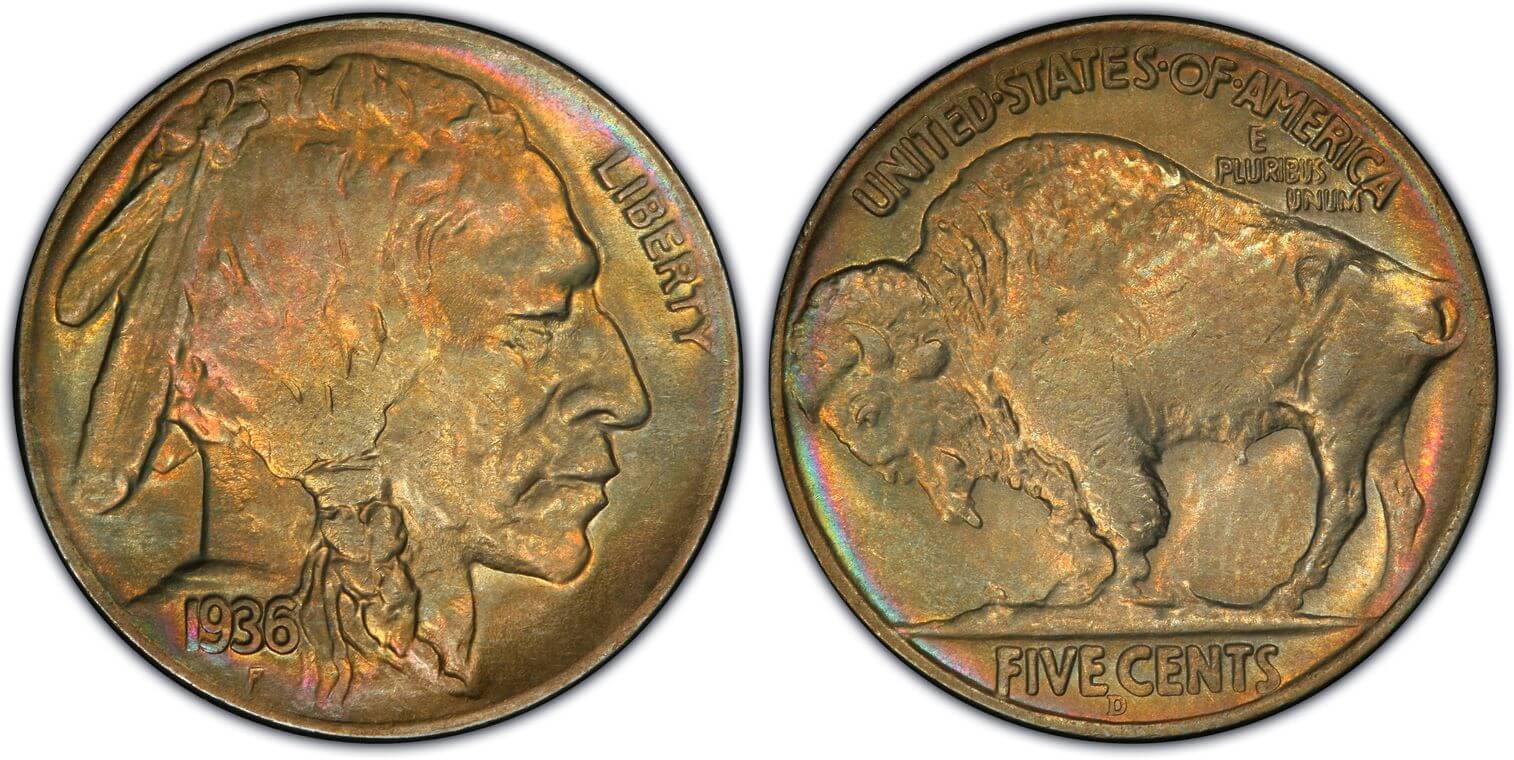1936-D 3-1/2 Legs Buffalo Nickels: The Strange Story (& Value)
In 1936, the U.S. Mint branch in Denver made 24,814,000 nickels. About three hundred or so of these Buffalo nickels were minted with an odd mistake: only 3 and a half legs on the bison.
Let's look at the fascinating story behind this strange error coin.
Why Are There Buffalo Nickels With 3 and a Half Legs?
How did this strange error coin come about? Like any of the various kinds of mint errors, it was a mistake that happened at the United States Mint in 1936. The missing half of a leg on the bison on the reverse was the result of coin dies that had been over-polished.

Photo courtesy of PCGS
Polishing of the dies is a normal practice at coin mints. However, if done excessively or with too much force, the polishing can wear away the finer aspects of the coin's design. This is what happened with the 1936-D nickel.
As you can see in the photograph above, the upper portion of the front leg is the part that is missing. The hoof should still be somewhat visible.
The bison (more commonly called a buffalo in the U.S.) designed by sculptor James Earle Fraser was modeled after Black Diamond, a famous bison at Central Park Zoo in New York City. Rest assured the real Black Diamond had four fully functional legs!
The 1936-D Buffalo nickel with 3 and a half legs is sometimes confused with the 1937-D 3-legged Buffalo nickel. Both of these error coins were made at the Denver Mint. The cause of the 3-legged error was a similar case of the dies being over-polished, yet that case resulted in the entire leg vanishing, hoof and all. Just remember that these are two different coins.
According to the most recent data, there are probably around 300 examples of this error coin known to exist. (PCGS has graded over 100 of them, but it's likely that this number is inflated by the same coin being submitted for grading more than once.)

1936-D 3-1/2 Leg Buffalo Nickel. Photo courtesy of PCGS
Value of the 1936-D 3 and a Half Leg Nickel
The 1936-D 3-1/2 legs nickel is perhaps the quintessential key to the entire Buffalo nickel series. The only dates of the Buffalo nickel that are valued higher are a pair of error varieties, the 1916 doubled die obverse (DDO) and 1918-D 8 over 7.
Interestingly, even though the 3 and a half legs variety is recognized by The Red Book and PCGS, it is no longer listed by NGC. It's not clear when the error was first noticed or identified. There's a strong possibility it's been known of by collectors since the time of minting.
Over time, the price of the 1936-D error coins has trended slightly lower. Basically, as more examples of this rare coin are found, they have become more affordable for collectors to obtain. Market demand for these rare nickels remains strong nonetheless, especially compared to other 1936 Buffalo nickels.
The most recent auction result for this type of Buffalo nickel came in September of 2022. An example graded XF-40 realized $3,850 at auction. The all-time high auction record occurred in 2009 when an example graded MS-63 sold for a remarkable $20,700.
Each column in the price chart below represents the numerical grade of the coin based on its condition. The abbreviations for each grade tier represent the following:
The main factors affecting the grade of a coin (i.e. its condition) are its wear, surface condition, strike quality, and overall eye appeal.
Given the significant jump in value for a 3-1/2 legs Buffalo nickel compared to its normal 1936-D counterpart, it's strongly recommended to have the coin professionally authenticated and graded prior to buying or selling. This also protects both buyer and seller from any potential counterfeit coins. Getting a rare coin graded will greatly add to its investment potential.
Read more about collecting coins from the numismatic experts at Gainesville Coins:
1936 Buffalo Nickel Value (With Price Charts)
Why You Shouldn't Trust Coin Values on Reddit
Best Coins to Invest In for 2024
The Strange Story of the Susan B. Anthony Dollar (& Values)
Surprising Value of 2009 Lincoln Penny Bicentennial Cents
How to Buy Junk Silver Coins: Complete Guide
Most Asked Questions About US Mint Coins: Buyer's Guide

Everett Millman
Everett has been the head content writer and market analyst at Gainesville Coins since 2013. He has a background in History and is deeply interested in how gold and silver have historically fit into the financial system.
In addition to blogging, Everett's work has been featured in Reuters, CNN Business, Bloomberg Radio, TD Ameritrade Network, CoinWeek, and has been referenced by the Washington Post.
